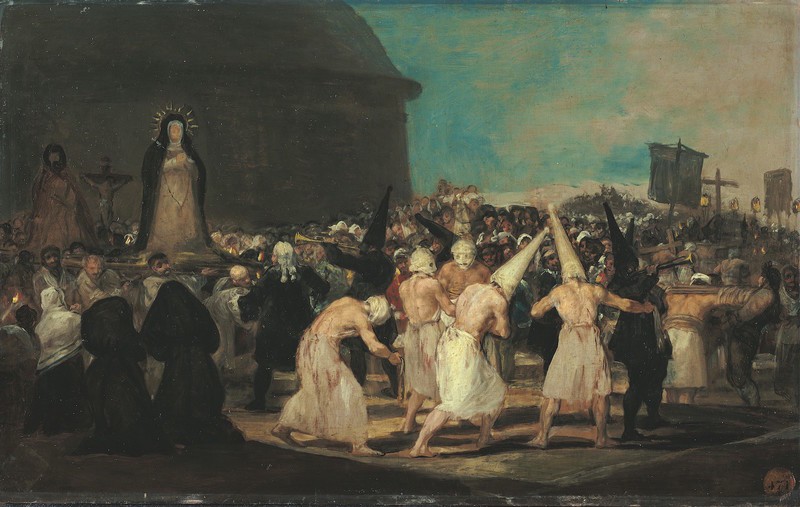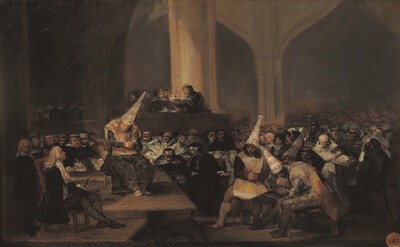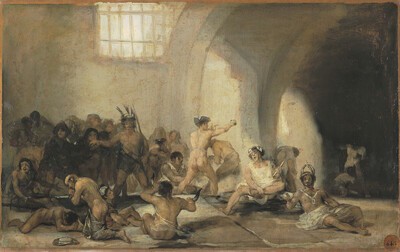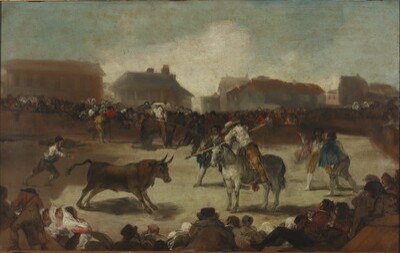- Cronología
- Ca. 1814 - 1816
- Ubicación
- Royal Academy of Fine Arts of San Fernando. Madrid, Madrid, Spain
- Dimensiones
- 46 x 73 cm
- Técnica y soporte
- Oil on wood panel
- Reconocimiento de la autoría de Goya
- Documented work
- Titular
- Royal Academy of Fine Arts of San Fernando
- Ficha: realización/revisión
- 27 Apr 2010 / 15 Jun 2023
- Inventario
- (674)
For a history of the whole series, see The Madhouse.
As in the case of the event represented in the painting The Bullfight, processions of flagellants were also banned in Spain following the return of Ferdinand VII in 1815. In spite of this, religious fanaticism and fervour amongst the population continued, as did the penitent tradition. Goya saw these processions as another manifestation of the irrationality of the people, and he represents the scene with all the rawness and realism which he knew just how to capture.
The procession which Goya depicts here seems to be taking place in a large city, as indicated by the presence of the bailiff in his white wig who tries to maintain order. As viewers we are placed in the position of spectators in the public, and we have a perfect view of the flagellants who, bare-chested and barefoot, their heads covered with white hoods, lash themselves until blood springs forth, staining their white clothing. These figures are interspersed with others dressed in black from head to toe with black conical caps or corozas who play the trumpet while others castigate themselves by carrying heavy blocks of wood on their shoulders. The religious figures carried in the procession appear on the left-hand side, led by the Virgin of Solitude, and followed by a Christ on the road to Calvary and a crucifixion. The poses of the veiled women who kneel before the Virgin express devotion, and all those present are humbled by the sight of the penitents and their pain except for one person, who, like the woman who meets the viewer's gaze in The Bullfight, looks at us from the crowd, raising her head above the white caps with an eloquent expression of horror.
-
Goya 1900Ministerio de Instrucción Pública and Bellas ArtesMadrid1900consultant editors Aureliano de Beruete, Alejandro Ferrant, Marqués de Pidal and Ricardo Velázquez. May 1900cat. 13
-
Goya. El Capricho y la Invención. Cuadros de gabinete, bocetos y miniaturasMuseo Nacional del PradoMadrid1993from November 18th 1993 to February 15th 1994. Exhibited also at the Royal Academy of Arts, London, March 18th to June 12th 1994 and The Art Institute of Chicago, Chicago, July 16th to October 16th 1994, consultant editors Manuela B. Mena Marqués and Juliet Wilson-Bareaucat. 96
-
Goya: Prophet der ModerneAlte NationalgalerieBerlin2005from July 13th to October 3th 2005. Exhibitied also at the Kunsthistorischemuseum, Vienna, October 18th 2005 to January 8th 2006, consultant editor Manuela B. Mena Marquéscat. 120
-
Goya en tiempos de guerraMuseo Nacional del PradoMadrid2008consultant editor Manuela B. Mena Marqués, from April 14th to July 13th 2008cat. 129
-
GoyaBasle2021p. 307
-
L'œuvre peint de Goya. 4 volsParís1928-1950vol. I, p. 243, cat. 214
-
Vie et ouvre de Francisco de GoyaParísOffice du livre1970pp. 256, 266, cat. 967
-
BarcelonaPolígrafa1970vol. I, p. 319, cat. 463
-
L’opera pittorica completa di GoyaMilanRizzoli1974p. 127, cat. 556
-
Francisco de Goya, 4 vols.ZaragozaCaja de Ahorros de Zaragoza, Aragón y Rioja1980-1982vol. III, p. 177 y vol. IV, p. 105 (il.)
-
Goya. El capricho y la invención. Cuadros de gabinete, bocetos y miniaturasMadridMuseo del Prado1993pp. 314-320, 378-379, cat. 96 y p. 317 (
-
Goya en tiempos de guerraMadridMuseo Nacional del Prado2008pp. 379-380, 384-386, cat. 129 y p. 385



